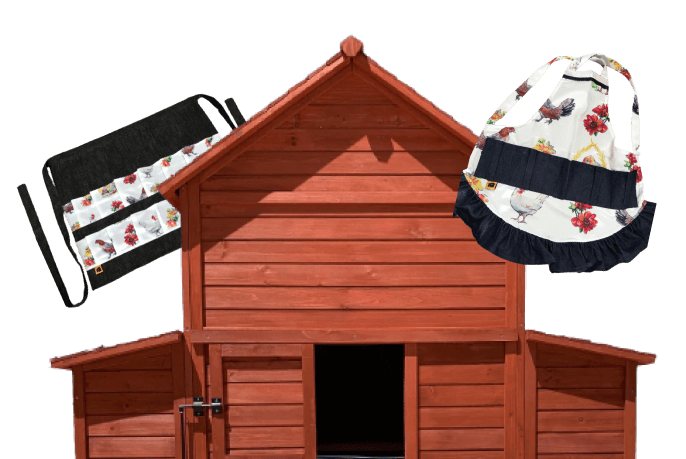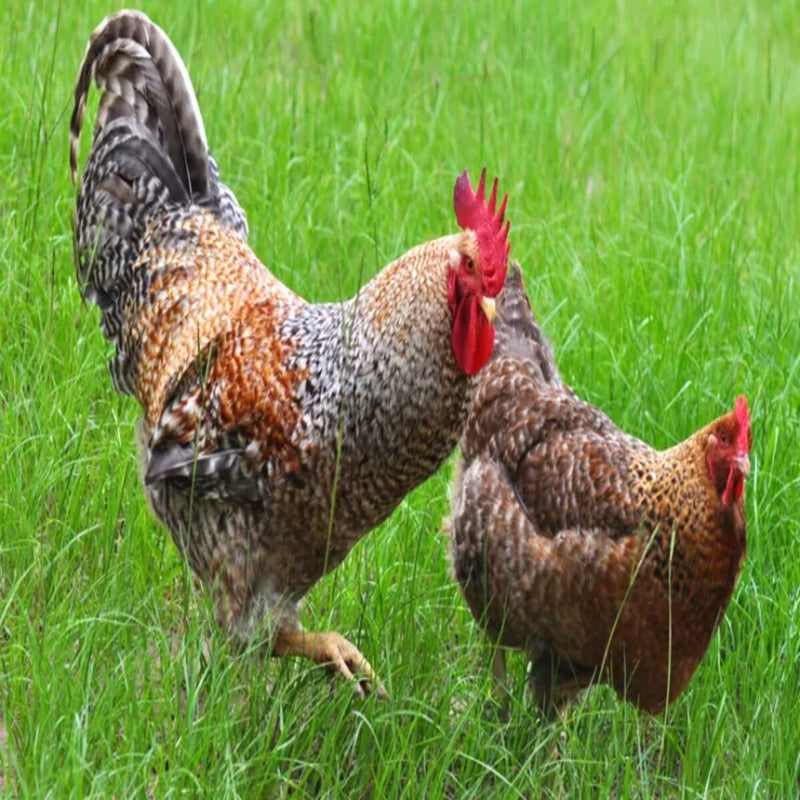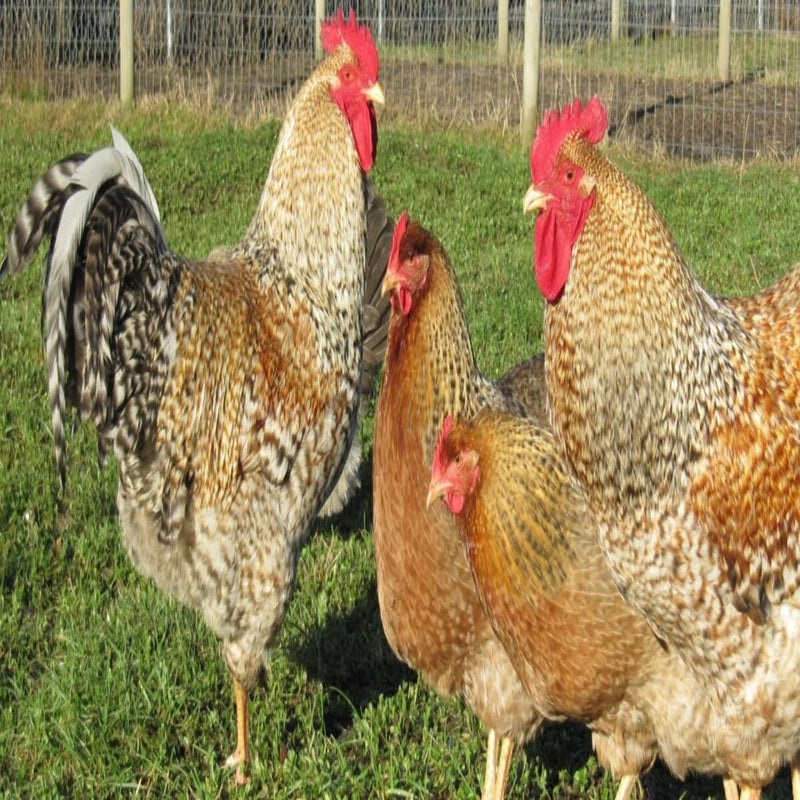-
Egg Quantity
Very Good (4/wk)
-
Egg Color
Cream
-
Cold Tolerance
Hardy In Winter
-
Heat Tolerance
Tolerates Heat Well
-
Abundance
Rare
-
Personality
Calm
-
Size
Large Fowl
-
Feathered Feet
No
-
Egg Size
Large
Bielefelder
Bielefelder Chicken
The Bielefelder chicken is a rare German breed, developed in the 1970s by Gerd Roth, using Amrocks (Barred Rocks), Malines, Rhode Island Reds, and New Hampshire chickens. Known as the "Uber Chicken," this breed is prized for its dual-purpose qualities and auto-sexing ability, where males and females can be easily distinguished at birth. Bielefelders are prolific layers of large to extra-large eggs and have a calm, friendly temperament, making them great for families with children.
Although the Bielefelder is a recognized Heritage breed in Germany, it hasn't yet been accepted into the American Standard of Perfection. However, it meets all other Heritage breed criteria: it's naturally mating, breeds true from like parent stock, and is not bred for rapid growth, ensuring a normal lifespan. The chicks are easily sexed at hatch—males are soft brown with a white spot on their heads, while females have a darker chipmunk pattern with a distinctive black mark across their eyes.
The Gentle Giants of Our Flock
One of the first things we noticed about our Bielefelder chickens was how gentle they were. They are super easy to handle and are a favorite among our kids on the homestead. Unlike some of our other breeds, the Bielefelders are not flighty and tend to stay within their boundaries, making them a breeze to manage.
We clipped the wings of most of our White Leghorns because they would fly over the fence despite having access to fresh pasture every two weeks as part of our pasture rotation.
Bielefelders are also calm so they integrate well with other chickens, reducing the chance of pecking order disputes. We have merged several flocks over the years and our Bielefelders have always gotten along with the newbies.
For example, we just added a dozen poults raised from eggs we hatched to the coop our Bielefelders have been in for a year; instead of bullying the newbies one night a handful of our Bielefelders (including both roosters) decided to give up their roosting space and sleep outside the coop.
Weight and Leg Injuries
Bielefelders are heavy which is one of the reasons they don’t fly over tall fences. But being heavy has its downside.
We have had 2 hens and 1 rooster injure their legs from jumping off high roosting bars. Their size makes them more prone to this type of injury so make sure to keep roosting bars low to the ground to prevent this. This is a big consideration if you are thinking of adding Bielefelders to your flock.
Egg Laying Performance
When it comes to egg production Bielefelders fall short of other breeds like White Leghorns. They will lay 200-230 eggs a year but are not as prolific as some of the more established egg laying breeds.

And their eggs are small. (I’ve heard from other homesteaders that their Bielefelders lay large eggs so your mileage may vary.)
But for a homesteader looking to maximize egg production 4 eggs a week on average is a big disappointment. We knew Bielefelders wouldn’t lay as many as our Leghorns but the smaller size (less volume per egg) was a bummer.
Dual-Purpose Benefits
One of the big advantages of the Bielefelder is its dual-purpose nature. Not only are they kept for eggs but they are also great meat birds. Their size and meat quality make them a valuable addition to the homestead for those who want to raise chickens for both eggs and meat.
After the leg injuries I mentioned above, we decided to harvest the meat of the 2 hens we had to cull. The meat was good but not as tender as Freedom Rangers.
This dual purpose can be a big plus for homesteaders looking to diversify their poultry benefits.
Roosters: Beautiful But Not the Best Protectors
Bielefelder roosters are gorgeous with their beautiful plumage. They are also gentle like the hens. But we found they are not as vigilant or effective at protecting the flock from predators as our white leghorn roosters. Their calm nature is a plus in some situations but makes them less reliable as coop guardians.
The other day I told my wife our Bielefelder rooster is just for show. We had 2 Bielefelder roosters until that night when half the flock decided to spend the night outside the coop. That night a raccoon came in and killed one of the roosters. I heard the commotion in the early morning hours and could tell the rooster didn’t put up much of a fight.
Containment and Escape
On the plus side Bielefelders don’t escape. Unlike our Leghorns and Black Stars they don’t fly over fences. This is a big plus for any homesteader who wants to keep a tidy flock.
Hardiness and Disease Resistance
Bielefelders are known for their hardiness and adaptability to different weather. We found them to be very hardy in hot and cold climates which is big for us living in central Georgia.
They seem to handle the summer heat well as long as they have shade and water. In the winter their dense feathering keeps them warm and they have not shown any signs of frostbite even on the coldest nights.
As for disease resistance Bielefelders are relatively hardy. Our flock has had very few health issues and they seem to be resistant to common poultry diseases. Regular health checks and a clean living environment has kept them healthy. This hardiness makes them a low-maintenance addition to any homestead, less time and effort required to care for them.
Frequently Asked Questions:
Yes, Bielefelder chickens are excellent layers, producing some of the largest brown eggs among our flocks at Greenfire Farms. You can expect around 200 to 230 eggs per year, which averages about 4 eggs per week.
Bielefelder chickens are indeed rare, which means they may come with a higher price and a longer waiting period. However, their unique qualities make them worth the wait. For instance, our Bielefelder rooster, Murray, once bravely faced a hungry coyote in the early spring.
Bielefelders are a dual-purpose breed, excelling in both egg production and meat quality. They grow quickly and provide a well-proportioned carcass. Hens typically produce around 230 large brown eggs annually, with each egg weighing about 60 grams. Bantam versions may lay around 160 eggs per year, with an average egg weight of 49 grams.
Yes, Bielefelder chickens are known for their calm, confident, and friendly nature. They are also auto-sexing, which means you can easily distinguish between male and female chicks at hatching.
Bielefelder hens start laying eggs at about 6 months of age. While they are slow to mature, they become reliable layers once they begin. They are also known for being intelligent and can easily adapt to different coop setups, taking cover when predators are near.
Yes, Bielefelders are rare, so they may be more expensive and require a longer wait time to acquire. But their qualities, such as the story of our rooster Murray facing off a coyote, prove they are worth the investment.
Bielefelder Facts
- Poultry Show Class: Not applicable
- Weights: Hen—–6 1/2 lbs
- Rooster——8 1/2 lbs
- Pullet–5 1/2 lbs
- Cockerel—–7 1/2 lbs
- Purpose and Type: Primary production, Egg Laying & Pet/Secondary meat source
- Egg Shell Color: Brown
- Egg Production: 230 eggs per year (estimates only)
- Egg Size: Large
- Temperament: Docile
- Gender Accuracy: 85-90%
- Fertility Percentage: 60-75%
- Broody: Setter
- Mating Ratio: 12 Females to 1 Males
- Roost Height: 2 to 4 feet
- Country of Origin: Germany
- APA: No
- TLC: No
- Breeder Farm Source: Poultry Breeding Farm has been developing our bloodline or strain of pure Bielefelders since 2017.
Notice: We do not sell items on Amazon or other websites.






